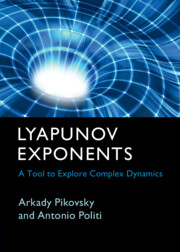Book contents
- Frontmatter
- Contents
- Preface
- 1 Introduction
- 2 The basics
- 3 Numerical methods
- 4 Lyapunov vectors
- 5 Fluctuations, finite-time and generalised exponents
- 6 Dimensions and dynamical entropies
- 7 Finite-amplitude exponents
- 8 Random systems
- 9 Coupled systems
- 10 High-dimensional systems: general
- 11 High-dimensional systems: Lyapunov vectors and finite-size effects
- 12 Applications
- Appendix A Reference models
- Appendix B Pseudocodes
- Appendix C Random matrices: some general formulas
- Appendix D Symbolic encoding
- Bibliography
- Index
10 - High-dimensional systems: general
Published online by Cambridge University Press: 05 February 2016
- Frontmatter
- Contents
- Preface
- 1 Introduction
- 2 The basics
- 3 Numerical methods
- 4 Lyapunov vectors
- 5 Fluctuations, finite-time and generalised exponents
- 6 Dimensions and dynamical entropies
- 7 Finite-amplitude exponents
- 8 Random systems
- 9 Coupled systems
- 10 High-dimensional systems: general
- 11 High-dimensional systems: Lyapunov vectors and finite-size effects
- 12 Applications
- Appendix A Reference models
- Appendix B Pseudocodes
- Appendix C Random matrices: some general formulas
- Appendix D Symbolic encoding
- Bibliography
- Index
Summary
In physical systems characterised by a large number of degrees of freedom, it is instructive to investigate the scaling behaviour of the Lyapunov spectrum with the “system size”. In this chapter we show that in many setups one can define a Lyapunov density spectrum when the number of degrees of freedom is large enough (i.e. in the so-called thermodynamic limit). Altogether, this is a manifestation of the extensive character of the underlying dynamics.
Dealing with infinite-dimensional systems poses a series of questions that have to be carefully investigated. First, it is no longer true that all norms are mutually equivalent; this, in fact, leads to ambiguities in the classification of a given dynamical behaviour as chaotic. Second, a problem of commutativity between the infinite-time limit and the thermodynamic (infinite-size) limit may arise.
In the specific case of spatially extended systems, it is natural to extend the analysis of infinitesimal perturbations to account for their spatial structure and possible propagation phenomena. The chronotopic approach provides a unified framework for a comprehensive characterisation of the space-time properties of tangent-space dynamics. This includes the definition of spatial Lyapunov exponents, convective exponents and a super-invariant entropy density. Occasionally, it is necessary to go beyond the linear stability analysis and to introduce the propagation velocity of finite perturbations, i.e. to study damage-spreading phenomena.
Selected model classes are specifically analyzed. Semi-analytical formulas of the entire Lyapunov spectrum are derived for a chain of Hamiltonian oscillators. Differential-delay equations that show analogies and differences with spatially extended systems are also discussed. Finally, some network structures are discussed to illustrate the shape of the Lyapunov spectrum in the presence of massive as well as sparse coupling.
Lyapunov density spectrum
In spatially extended systems, the number N of degrees of freedom is proportional to the system size. The reader can, for simplicity, just think of a finite discrete lattice where each site is characterised by d variables. In a one-dimensional chain composed of L elements, one has N = dL (in the case of coupled logistic maps (A.10), d = 1 since the local variable is a scalar; in a chain of Rossler oscillators (A.17), d = 3).
- Type
- Chapter
- Information
- Lyapunov ExponentsA Tool to Explore Complex Dynamics, pp. 168 - 199Publisher: Cambridge University PressPrint publication year: 2016



